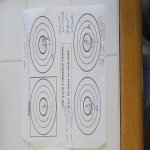It's absolutely correct that in rimfire neither precision nor accuracy can be bought. It goes without saying that in every discipline, shooters must know what they are doing, or they invariably can't do well without good fortune.
Without getting into a micturition challenge, however, I'll explain that I prefer to think of precision in the way it's meant in the English language -- "the quality, condition, or fact of being exact and accurate". In rifle shooting in general the image below conveys the meaning of "precision".
My thinking is that expectations of "precision" are not practical with .22LR shooting at square targets varying from 4" to 12" at distances from 100 yards out to 300, as is required in some PRS stages. Others may disagree, but that's why I used quotation marks with the word with reference to PRS shooting.

The current standard for the basic new shooter 25-100yd matches (ORPS) is an 1 1/2” diameter round target at 50 and 2-3” diameter round target at 100. The September Course of Fire includes a 1/2” round target at 50yds. The general standard is 10 shots, 5+ position changes, 2-4 targets, and a 120sec time limit. Many of the submissions to the 10 shot groups at 100 thread, shooting off the bench no less, average between 1” and 1 1/2” while watching wind flags and choosing when to shoot. The Rimfire PRS crowd need to do that in multiple field positions whenever their 2 min starts, in order to be podium competitive. The “big boy” matches add in ranges from 50 to 300 under the same positional and time constraints. It’s a tough gig.








































































